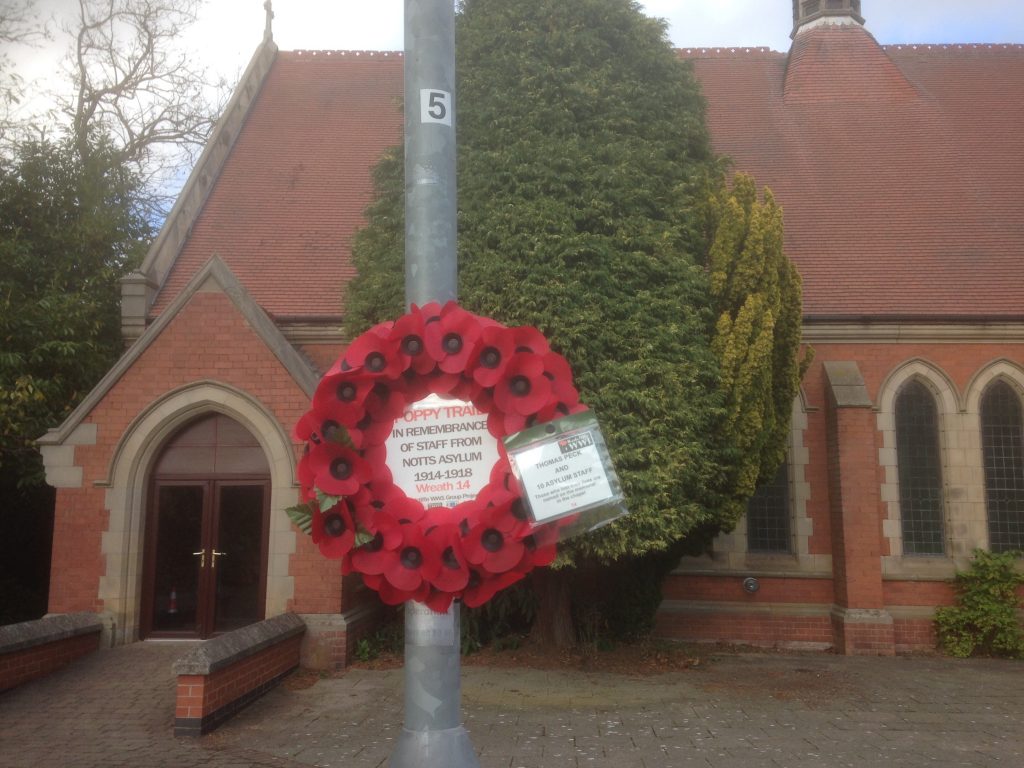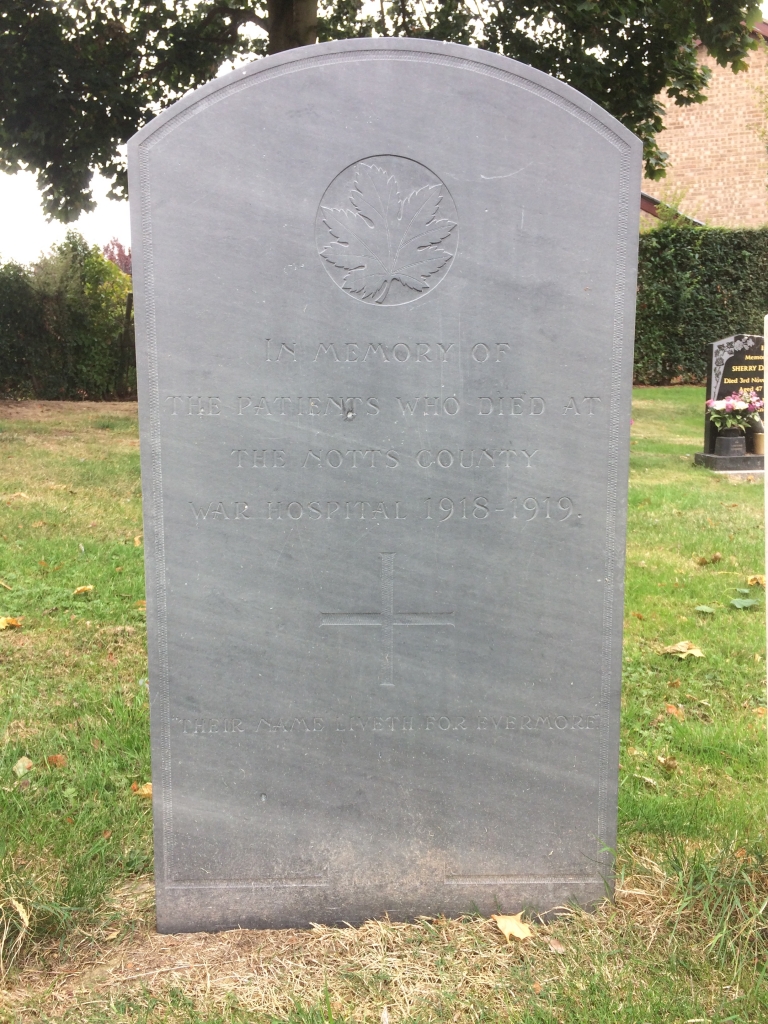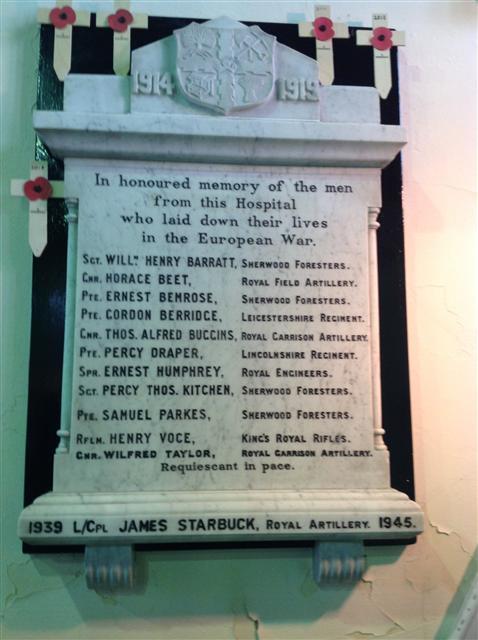Notts County Asylum WW1 Memorial
 Former chapel of Notts County Asylum
Former chapel of Notts County Asylum
and Armistice centenary wreath commemorating staff who died
Nottinghamshire County Asylum, opened in 1902, was situated at Saxondale in the parish of Radcliffe on Trent. In 1914 the isolated complex located two miles outside the main village housed several hundred patients and a fairly small staff of thirty-one male attendants, a number of farm workers and artisans together with female nurses and domestics. When war was declared, the male staff included those eligible for war service. Despite appeals from the hospital for staff to be exempted from military service, a large number left for the war between 1914–1918 and eleven lost their lives.
Twelve male staff were called up immediately war was declared (a thirteenth man, Ernest Bemrose, who left the hospital’s employment between April and July 1914, was also called up and is named on the hospital memorial). Nine of these thirteen men have been positively identified by us as reservists who served in the British Army before WWI. They were among the first to enter the war, were all awarded the 1914 Star and six lost their lives.
As the war continued other male staff members (including some who were in the territorials) either volunteered or were conscripted. By October 1915 a further fourteen attendants had been called up (Nottingham Evening Post, October 16th, 1915). Of these fourteen, seven have been identified serving in theatres of war in 1915; they were awarded the 1914–1915 Star. The 42nd Annual Report on the state of the Lunatic Asylum for the county of Nottingham for the year ending December 1916 reported that thirty seven male staff members had left the hospital for active service since 1914. A further seven were called up during 1917-18. By the end of the war forty-four male staff in total had served and ten had been killed in action or died of illness:
William Barratt (killed 1916); Horace Beet (died 1918), Gordon Berridge (died 1915), Thomas Buggins (died 1917); Percy Draper (killed 1915), Ernest Humphrey (died 1920), Percy Kitchen (killed 1916); Samuel Parkes (killed 1918) Wilfred Taylor (died 1921), Henry Voce (killed 1914).
Memorial Tablet
Former chapel of Notts. County Asylum, now the Wellspring Christian Growth Centre
The minutes of staff meetings at the Asylum were kept meticulously during the war and are available in at the Nottinghamshire Archives, Nottingham. They show concern for staff who left to fight and those who lost their lives are recorded and remembered with sorrow.
The staff are commemorated on a tablet in the hospital’s former chapel, now known as the Wellspring Christian Growth Centre. Nine of them are also inscribed on Radcliffe on Trent Memorial. Two of the names are omitted from the Radcliffe memorial. Ernest Humphrey, who died in Nottingham in 1920, is commemorated on the memorial in Nottingham General Cemetery. Wilfred Jackson Taylor died in 1921 after the unveiling of the Radcliffe memorial. He was buried in Radcliffe cemetery.
Edward Gamble is not on the Asylum memorial tablet despite being awarded the 1914-1915 Star and having several years of employment at the hospital both before and after the war. He died of tuberculosis in 1923.
Notts. County War Hospital patients who died in Radcliffe on Trent
Nottinghamshire County Asylum was converted to Nottinghamshire County War Hospital in the summer of 1918, receiving over a thousand servicemen who had been traumatised by the war. After thirteen months, the patients were discharged or moved on and the hospital reverted to its former status as an asylum. It was later renamed Saxondale Hospital and remained in use treating patients with mental illnesses until the 1980s.
Around thirty servicemen died at the hospital between 1918 and 1919. We are in the process of investigating the reasons; we know some died from influenza and others from war injuries. Most men’s bodies were returned to their families. However, five patients who died were given a full military funeral and are buried in Radcliffe on Trent cemetery: Bernard Fitzgerald, Edward Hoppe, Herbert Maddock, Augustus Sage (known as Clement) and Harry Smith. Their names were not inscribed on the Radcliffe memorial; they are included on the Radcliffe on Trent Roll of Honour so they would not be forgotten. These men had tenuous connections to the village and were only at the hospital for a few weeks. It seems to have been a common practice to omit names of servicemen who died in U.K. military hospitals from memorials in the places where their lives ended.
We have been unable to find records of these five men being remembered individually elsewhere in the UK. However, a headstone in Radcliffe on Trent cemetery commemorates all who died at the hospital. It is placed near the five graves and is inscribed with the words ‘In memory of the patients who died at Notts. County War Hospital 1918-1919’.


